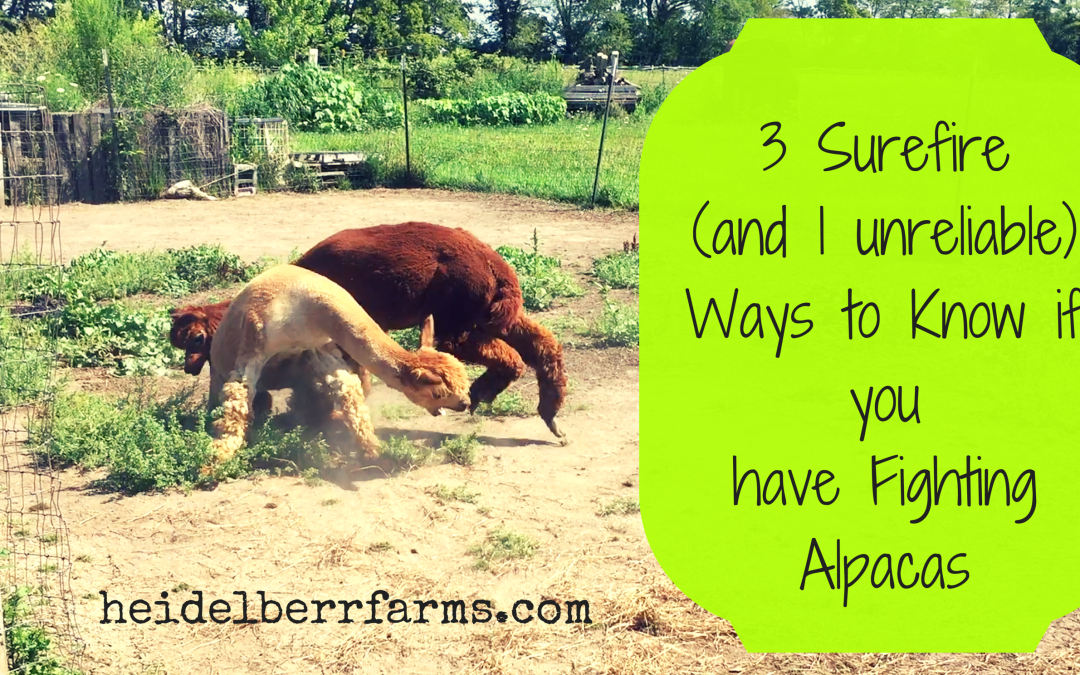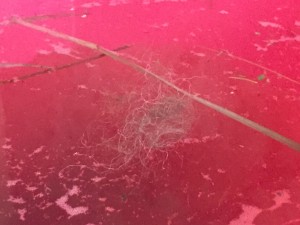3 Surefire (and 1 Unreliable) Ways to Know if you have Fighting Alpacas
If you have spent any time at all around animals, you understand that all is not always peaceful in the kingdom. You’ve probably heard well meaning people wish that people were more like animals so that the world would be a more peaceful place?
Tripe.
Tripe and lies.
Now alpacas are great. As a species, they are fairly laid-back and peaceful. Alpacas aren’t inclined towards human aggression, although I always espouse caution when working with any animal, alpacas included.
If you work with animals long enough, weird things happen. Occasionally, even the most patient and kind family dog or “bombproof” horse will have a bad day and someone will end up hurt.
Inter-species aggression is common to many creatures and alpacas are no exception. Most cases of aggression occur between intact males. Sorry guys. I’m not hating on anyone here, but a consistent factor across creation is the fact that dudes have a tendency to fight.
Back to alpacas. If you are seriously considering getting into alpacas then you need to make peace with the fact that if you have more than one male, they will probably get into a physical altercation at some point. Know this now and have a plan for how to address fighting when it occurs. If you have two easy-going boys, they may never get into an argument. I suppose it could happen.
Fish gonna swim. Critters gonna fight. Most often fighting occurs between the male of the species, but not always. In my experience, female alpacas do fight although their fighting style differs greatly.
Unlike human girl fights, alpaca females tend not to fight for blood. Most often, fighting is relegated towards the protection of resources. In my herd, the girls are competitive for the prime spot at the sprinkler on a hot day, special treats placed in the feed bins, the shadiest spot in the shelter, or (in the case of pregnant females) the very air that they breathe.
Alpaca girls usually resort to screaming and spitting to voice their displeasure. I have never seen my girls resort to physical brawling. They tend to just hover over whatever they claim as theirs and scream loudly and longly until the other yields. It’s noisy, but harmless.
Not so the boys.
Tell me if growing up you’ve ever heard the words “You’re playing now, but someone’s gonna get hurt.”
Many times boy fights start as innocent play wrestling and then escalates from there.
Male alpacas have a hierarchy that must be settled routinely and on numerous occasions.
If there is a female on the property who is not currently pregnant, the hierarchy must be re-established.
If one of the girls glances too long in the boys’ direction, the hierarchy is scratched and must be re-established.
If one of the boys steals another’s special blade of grass, the hierarchy must be re-established.
If it’s a sunny, rainy, windy, still, cold, or warm day, the hierarchy must be re-established.
So as you would guess (boys being boys) much of the fighting stems around the quest to win reproductive rights but fighting can also take place because your face is annoying and I’m tired of you and also a fly bit me.
The last thing that I want to do is to talk any prospective owner out of getting into alpacas simply on the basis of fighting. As livestock goes, alpaca fights are mild and rarely serious to the point of major injury so long as their wolf teeth are kept trimmed.
Click here to see a video example of a mild fight between Elwood and Baby Burton. Notice how it started off as an attempt by Baby Burton to play and escalated quickly from there. This fight was over almost as soon as it began. Thankfully, this is a typical “fight” and as such does not cause much concern nor does it warrant interference.
I may delve further into this topic at a later point, but for now I want to focus on teaching you how to tell if your alpacas have been fighting. You may have a herd composed of low-key individuals who never fight a day in their life. Most of the time, this is exactly the case.
However, you may be like many of us alpaca owners who also have to hold down day jobs. How can you tell if you have a peaceful herd or if your guys have been rumbling like the Sharks and the Jets behind Officer Krupcke’s back?
Thankfully, I have 3 easy ways (and one difficult way) to tell if your alpaca is a Greaser or a Soc.
EASY WAY #1: LOOK TO THE DIRT
I will admit to you that for this method to be effective, you need the proper terrain. A dry lot works best. You will need a bare patch of earth or other substrate which will provide a means to view disturbances in the covering.
Alpacas are classified as light livestock weighing between 120-200 pounds. Their feet are padded and they tread very lightly. Usually, these treads are visible and create only light disturbances in loose dirt. Such tracks are shallow and clear defined with little outlining.
As they peacefully walk along, each footfall is lifted up and placed directly onto the soil.
However, when two (or more) alpacas are involved in a fight, everything changes. They have a lower center of gravity not unlike two sumo wrestlers trying to push each other out of the ring.
You may see a variety of track patterns, but here are some of the most common.
Ex A: Deep tracks with a large outline.
Shallow tracks are normal tracks. They’re peaceful tracks.
Deep tracks are war tracks. Deep tracks indicate the lowered center of gravity combined with shifting and twisting as the alpaca tries to deepen his grip for traction. The shifting creates depth and piles dirt around the outline as you can see here. If you see a large grouping of deep tracks in a concentrated area, you probably have fighting alpacas.
Ex B: Tracks with runners
When you see a track with running lines leading up to it or behind it, you can be assured that your alpacas have been fighting. These types of tracks also correspond with the sumo-esque wrestling that typifies an alpaca fight. One alpaca pushes another and either drags his feet as he pushes or drags his feet as he is being pushed.
Learn to read the language of alpaca tracks. Tracks will spill the secrets of sneaky alpacas.
(You could probably taste them like they used to do in old western movies, but it’s probably not necessary.)
EASY WAY #2: HAIR IN INAPPROPRIATE PLACES
Alpacas are not a bitey species by nature. You really don’t have to worry about being bitten when working with an alpaca. Granted, I never say never, but it just doesn’t seem to occur to them to use teeth as a weapon against humans.
When boys fight amongst themselves, they bite. Alpacas don’t have upper teeth, just a hard upper palate with dull lower teeth used to pinch off blades of grass.
However, the boys do grow very sharp canines (called wolf teeth) further back in their mouth that they use almost exclusively to eliminate rivals.
And when they bite, they play for keeps. Each alpaca will attempt to cripple the other by severing a tendon in his leg. More seriously, they will attempt to eliminate their rival’s genetic impact within the herd by castrating him. Y’ouch!
I told you it’s serious business.
I digress–back to hair. Like reading the tracks, reading the hair can reveal a wealth of information.
If you find hair floating in the water bucket, you can be assured that your boys have been fighting. Since they are trying to cripple and/or castrate, they are also ripping out fiber in the process. This fiber is going to stick in and around their mouth until they rinse or rub it off.
Since fighting takes a lot of energy, an alpaca will want to refresh himself with a cool drink of water. The fiber rinses off his face. You are left with the evidence.
I have even narrowed down the offending parties by matching the fiber colors back to the original owners.
Eat your heart out C.S.I.
EASY WAY #3: LEARN THE WAY OF THE POOP
One thing that you must learn about alpaca boys (or 12 year old human boys) is that poop is a central part of their very identity. Poop is important stuff.
Poop is worth defending. Poop is worthing fighting for. Poop is worth fighting over.
Most days, the boys are very good about sharing their communal poop pile.
Just because they share well most days does not mean that once in a while, one alpaca will want to initiate an exclusivity contract.
As you know, poop is a territory marker for many species. If the females venture close enough to the males and there happen to be open (not pregnant) females around, this can trigger a cascade of testosterone in the boys’ herd and upset the hierarchy.
When this happens, the boys can get just a bit tetchy when it comes to poop and the ownership thereof.
When fighting breaks out over and around the poop pile, it will get buried in dirt during the scuffle. Remember that the poop pile is treasured ground in the alpaca world. As a habit, they tend to not mess with their piles.
So when you see a buried poop pile, you can be assured that the boys had a momentary loss of judgement and forgot where they were when someone declared IT’S ON!
THE UNRELIABLE AND DIFFICULT WAY: FACIAL PROFILING
I have gone back and forth whether or not to even mention this method. It’s not only difficult to master, but it’s unreliable as well.
I recommend using it in conjunction with the previously mentioned methods and not as a stand alone.
Now once you get alpacas of your own and once you learn each individual’s personality, you may start to master this method.
Keep in mind to give yourself plenty of patience and time. There will be frustration, but I know that you can do this. If you start your herd with one of my animals, know that this is not a one-time only transaction. I am available to you as a mentor so that you can advance in the learning curve.
Just because this process isn’t easy does not mean that it’s not worth doing.
Alright. Here we go.
On rare occasions, you can pick up very minute differences in expressions that will tell you if your alpaca has been fighting.
Again, this method is not reliable and it is not easy to pick up the very subtle clues that alpacas will send to each other. As humans, we simply do not operate on this wavelength.
Here are two examples. I know that Elwood and Esteban were fighting because I witnessed them in action. That is how I can show these pictures to you in full confidence. Use these as a template for your own animals.
Example 1: Elwood
Look carefully toward’s Elwood’s right ear. It is angled ever so slightly turned away from me in this picture. Notice also his slightly softened eye on the same side.
Don’t feel bad if you don’t see these differences right away. It took me a long time. Keep practicing and I promise you that these things will start to pop out at you.
Example 2: Esteban
I’m saving the hardest for last since Esteban’s example is very difficult to interpret.
You will see with Esteban’s very handsome face that he is even more subtle with his facial expressions. Notice his drooped ear and ever-so-slight angling of his head and a near 45 degree angle. These are classic signs of an alpaca after a fight.
You can see from the subtlety of these pictures that it is not at all easy to identify fighting alpacas solely based on their facial features. Alpacas certainly don’t give us much to go on when looking only at their faces to see what they might be thinking.
I would be tempted to say that it’s practically impossible. But since I never say never, then I will instead wish you the best of luck if you think that you can pull it off.
Now that you have learned a few surefire (and one unreliable) way to tell if you have fighting alpacas, you may be wondering what to do with this information.
In a future post, I will outline what you can do when your alpacas fight as well as my surefire method to get them to stop practically immediately.
Thankfully, serious fights are rare. As a word of precaution, I will warn anyone who works around alpacas to not attempt to physically break up an alpaca fight. As with fighting dogs, getting into the middle of two fighting alpacas is a horrible idea.
Alpacas are remarkable and gentle animals. However, 150 pounds of normally gentle animal is not going to pay attention to your safety when he has more important concerns on his mind and you just happen to be in his way.
Wait, what? What do you mean you can tell they’ve been fighting because their mouths are hanging down and dripping with green goo? That’s just crazy talk.
Have you found this guide helpful? Do you have a fight story to share? I’d love to hear it in the comments below.










Loved your post. Most informative about fighting that I’ve come across. Waiting to read about when to intervene when a dominant male is terrorizing another male.
Hello and my sincerest apologies for not seeing this much sooner. I had thousands of spam messages to wade through.
If I were concerned about a dominant male causing injury to another alpaca, I would absolutely consider calling the vet and scheduling a castration. Without knowing the specifics, sometimes you can reduce tensions by adding more males. Seems counter-intuitive, but having more males means that one poor male isn’t having to take all of the punishment.
One other thought is to add a gelded male llama. I’ve heard many other farms having tremendous success by having a llama bouncer to help maintain order.
Best of luck!
Hi,great reading thank you…I have 4 alpaca,3 females and one wethered boy.They are all 14 months old….The boss of the group is very,very bossy .I have seen her physically fighting wth the other two females who are very gentle souls and today it was a full on fight with the castrated male who is also easy going and gentle.Today was biting and trying to push the other to the ground.The boss has always seemingly picked on the others because she can,she spits at the drop of a hat..I met her mum a few weeks ago,she is also the boss of her herd of 10..Doubt there is anything that can train her otherwise,I think she just has this bossy streak and enjoys being top dog.She really is a bully.Be interesting what you think as it is apparently out side the box of average behaviour,much appreciated,sincerely Lyn.
Hi Lyn,
She indeed sounds like she thinks that she is the boss. It’s not unusual for some females to have, um, ‘strong’ personalities. Some females are hateful when they’re pregnant and very sweet when they’re not. Other females are the opposite. There are so many ranges of ‘normal’ that it can be hard to tell. While it sounds like this might be a learned behavior, since your bossy females mother was also boss of the herd, the fact that your girl is so physical with the others is what I find most unusual.
The girl fights don’t usual get so physical. Especially not to the point of pushing down to the ground and biting. That’s classic male behavior. I would actually be interested in what a veterinarian would think in this situation. A physical exam may reveal something that could be causing her hormones to go a little crazy. Years ago, I worked for a horse farm. There was this mare (a rather hateful one at that) that had a huge cyst on her ovary that caused her to exhibit stallion behaviors. I’m not saying that’s what’s wrong with your girl. Just a suggestion.
Best of luck to you with her. Having an exceptionally bossy boss can be very taxing. I feel you there!